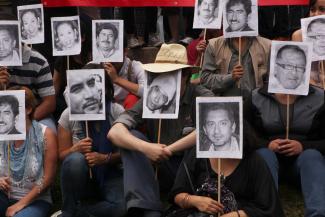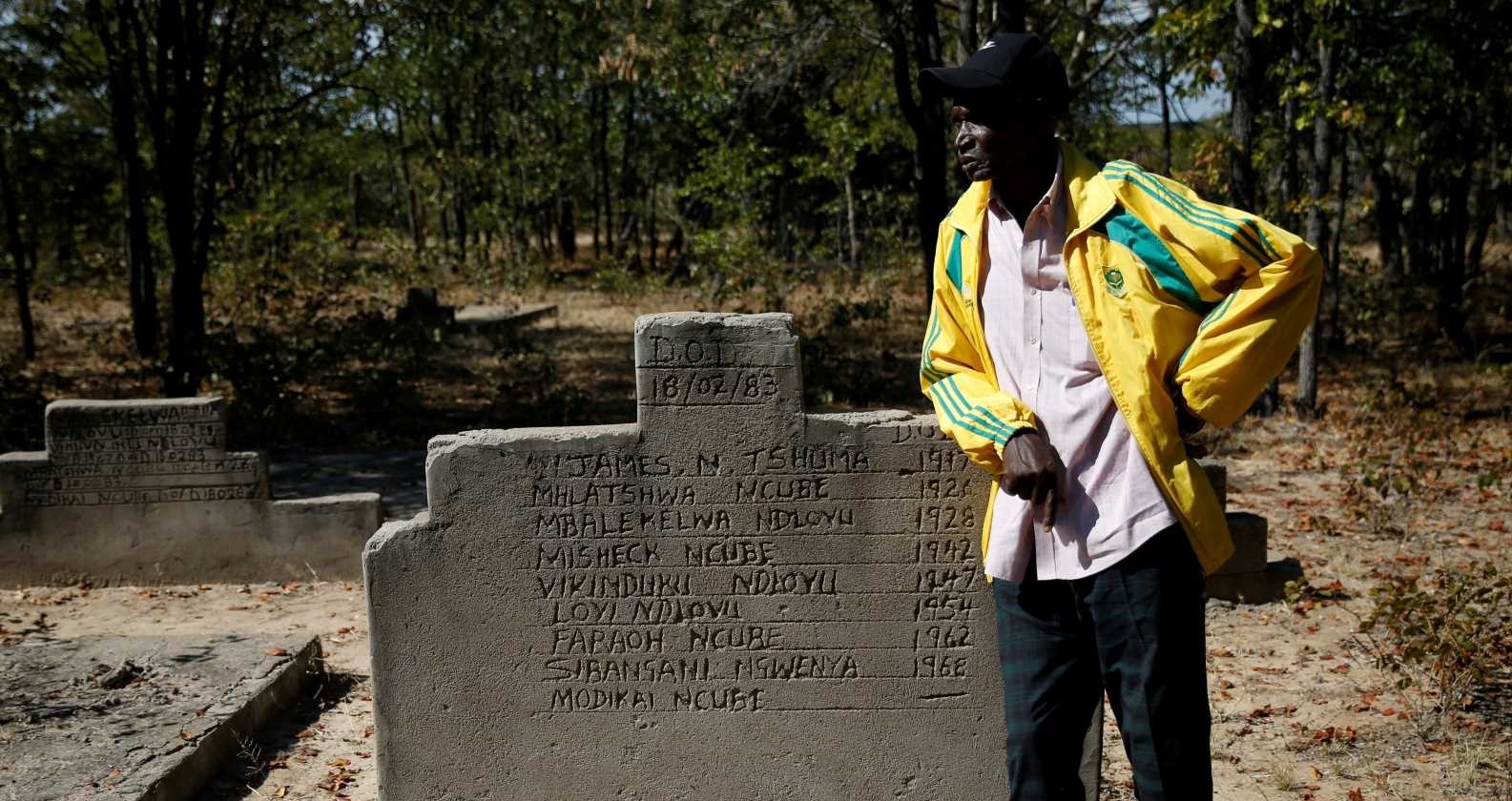Journalists
Staying safe and sane

In August this year, ISIS terrorists published gruesome videos showing the execution of Jim Foley and Steven Sotloff, two journalists from the USA. The images spared no details and made the international public aware of the danger foreign correspondents are exposed to in crisis areas. Local journalists of countries that are rocked by violence and conflict put their physical and mental health at risk daily.
According to the human-rights organisation Reporters without Borders, more than 71 journalists as well as 39 bloggers and citizen journalists were killed worldwide in 2013, and 87 were kidnapped – more than twice as many as in 2012. Hundreds were jailed and tortured. Syria, Eritrea and Somalia are currently the most dangerous places for media workers.
The profession is similarly dangerous in countries such as Mexico, where the fight against the drug mafia claims lives every day. According to the UN, 80 reporters were killed or “disappeared” while doing their work in Mexico the past twelve years. Reporters without Borders put Mexico in the same category as dangerous countries for journalists, like Iraq and Pakistan, and speak of a “culture of violence against the press”.
Since 1992, more than 1083 journalists and media workers have been murdered all over the world. Most of them were not international war correspondents, but local journalists, according to the Committee to Protect Journalists (CPJ), an independent organisation based in New York. Journalists are often threatened, kidnapped, persecuted or tortured. The perpetrators are terrorists, security personnel and sometimes even the police. Journalists from local communities are particularly exposed to such danger. Most crimes against journalists go unpunished and have no legal consequences. In Mexico, for example, only around two percent of the perpetrators who assault journalists are prosecuted. Violence results in media self-censorship and a constant state of fear.
Article 19 of the Universal Declaration of Human Rights states that everybody has the right to freedom of opinion and expression, and Article 3 states the right to security of person. It is a huge challenge to enforce these rights everywhere.
Unwanted memories and nightmares
While there are a few training opportunities to prepare journalists, photographers and cameramen for assignments in crisis areas today, there are hardly any systematic options for bracing oneself for the mental stress of witnessing unimaginable violence. The emotional repercussions of journalistic assignments tend to be vastly under-estimated. They include unwanted memories, nightmares or flashbacks. And this kind of mental strain is reinforced every time a journalist is sent on a new assignment in a crisis situation, be it in Syria, Iraq or Afghanistan.
In 2004, Gregor Sonderegger was the Russia correspondent for Swiss TV. He reported live from Beslan in North Ossetia-Alania, where terrorists had occupied a school and taken more than a thousand hostages. In this tragedy in the Caucasus, more than 330 people lost their lives, many of them children. “Never before I had seen children dying,” Sonderegger recalls. “Had I had children of my own at the time, as I do now, I couldn’t have reported from Beslan.”
Remembering Haiti’s devastating earthquake of 2010, Roosevelt Jean Francois says: “It is impossible to cope with those situations on your own.” Francois is the director CECOSIDA, an organisation of journalists in Haiti. “At first, you function as if on autopilot, you report night and day, focussing only on your work,” he says, “but later, everything comes back to haunt you.”
Lasting mental harm
In 1994, Bruce Shapiro, then an investigative journalist and civil-society activist in New York, was shot by a person running amok. Shapiro survived the attack, and then experienced colleagues following him all the way to the hospital bed, demanding an interview. His view of journalism changed radically. In cooperation with Frank Ochberg, a psychiatrist, and with financial support by the wealthy Dart family, he founded the Dart Center for Trauma and Journalism in 1999. It has since become part of Columbia University in New York. To date, this small centre is the only entity worldwide that trains journalists in reporting tragedies and violence in a sensitive and professional manner. The Dart Center opposes the myth of journalists always being tough, hard-boiled reporter who deal with all wars and crises of the world on their own.
A study by Anthony Feinstein, a Canadian psychiatrist, showed in 2004 that the risk of lasting mental harm is especially high for war reporters. His survey of 140 international journalists revealed that 28 % suffered from post-traumatic stress disorder (PTSD) at some point of their carrier. In a more recent study in 2012, Feinstein assessed the situation of journalists who work in a country like Mexico in a context of violence and constant danger. Of 104 surveyed journalists who covered gang violence and illegal drug trafficking, 25 % developed PTSD symptoms, including depression. Due to the daily threats, they had to give up their work.
Not all journalists who report about war and crisis will be traumatised, but anxiety disorders are common. Noises, images, sounds and smells connected to an experience of violence can be etched into the mind so deeply that they gain a life of their own. Journalists who are affected may be terrified by peaceful fireworks long after having returned form their assignment to a safe home. They may fear crowds of people or sexual assaults – as they witnessed on the Tahrir square in Cairo for example. Others are haunted by vividly recurring memories of a colleague who was shot.
Media houses and editorial offices back home tend not to know how to deal appropriately with the reporters they expose to danger. Editorial staff at the head office oversee assignment, but they normally have no first-hand experience of crisis areas, nor do they have an understanding of how to prepare the reporters for crisis scenarios abroad. Wrong decisions, however, may have serious consequences.
Interviewing victims sensitively
Journalism schools teach students to interview politicians, stars and other eloquent persons, but journalists are normally not taught how to talk with people who have experienced something traumatic. Victims of violence, people who were tortured or raped in war or who have suffered hunger must be interviewed in a different manner than politicians or celebrities.
The fundamental and iron rule is: “Do no harm.” Dart Center workshops impart how journalists can deal empathetically with victims of sexualised violence, people who have lost loved ones or who have survived an assault. It is important to understand that traumatised people are not reliable sources, because their perceptions can be twisted. Moreover, the experience of an interviewee can also prove to be “contagious”, as trauma therapist and media teacher Fee Rojas puts it, when journalists feel strong empathy with victims. The Dart Center invites people from aid agencies and victims’ associations to share their insights with workshop participants. Such exchange is fruitful.
Journalists have to learn what supports them in their daily work. Things that matter include support from colleagues, strategies of self-care, chats with friends, social networks and – last but not least – the act of writing and reporting itself. Journalists who tackle these matters in their coverage are less at risk of emotional harm than photojournalists, cameramen and media technicians. In order to cope with memories, it is important not to deny them, but to accept them as part of one’s life. It is also essential to acknowledge that having nightmares is normal – and to fetch help if they do not stop.
International agencies provide only few training opportunities and support programmes for journalists in developing countries and especially in crisis states. The CPJ and Reporters without Borders offer some support to journalists in need and their families in terms of asylum, grants, medical care and financial assistance. Both organisations also provide information on security measures and precaution. The Rory Peck Trust Fund and the News Safety Institute organise security trainings too. A few years ago, the International Red Cross established a hotline and an e-mail address for journalists in distress with an eye to organising help. The idea is to mobilise medical assistance in case of a sudden incident, or to get in touch with a hostage’s kidnapper for instance.
However, psychological support is not offered in the systematic and sustainable way needed. After a workshop with Dart Center and local trauma therapists, Francois, the Haitian journalist, developed a “peer support” system among local journalists in Haiti. In 2007, in Cambodia a training for local journalists took place, co-organised by the Dart Center. The focus was on what the media can do to facilitate coming to terms with a violent past. The violent terrorism of the Khmer Rouge regime traumatised many Cambodians, including journalists, and the impact is still felt today. Almost all families lost loved ones.
Humanitarian-relief agencies prepare staff for crisis missions as a standard routine, but media houses do not do so. One reason is lack of funds, especially in view of the dwindling media revenues in rich nations. This is the wrong approach to saving money however. Journalists who report unscathed and in a balanced way from war and crisis zones, after all, safeguard the freedoms of expression and opinion.
Petra Tabeling coordinates the German office of the Dart Center for Trauma and Journalism in Cologne. petra.tabeling@dartcenter.org









